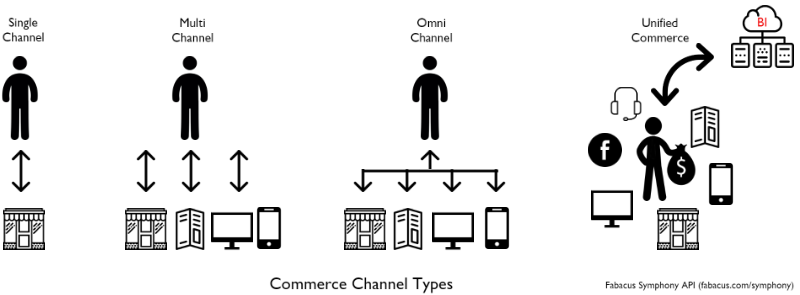The relationship between brands and consumers has fundamentally shifted in the digital age.
Consumers are more connected to commerce than ever before. They can shop from their bed on their smartphone, ask sales questions on social networks and read hundreds of product reviews before purchasing. They have multiple devices to purchase anything from wholesale to discount distributers and can ship almost any good to almost anyone across the world.
How can brands keep track of consumers that flit so easily between platforms and devices? What is the best framework for keeping up, especially with millennial and Gen Z consumers, who get from platform to platform at lightening speed?
The best answer we have right now is a unified commerce strategy, one where all of a brand's channels are connected in real time. By looking at the way consumers are behaving and looking at the weaknesses in previous brand efforts to track consumers, we'll discuss unified commerce strategy, and show why identity is the key to a unified strategy.
Consumers of today are ahead of retailers
The consumer of today is steeped in technology, and it can be a nightmare for retailers, because consumers don't care about how hard they are to track.
They might sign up on your site with an email one day but use social login five months later when they forgot their password. They put things in their cart that they end up purchasing in-store. They browse on their phone during their commute but make that purchase when they get to their job on their work computer (who hasn't?).
Mapping out the shopping journey means stitching together so many actions across so many channels that even with big tools like Facebook's in-store purchase tracker, companies still have a hard time figuring out how people are making purchase decisions — especially if they're an SMB.
Millennials and Gen Z: Challenging Demographic
Millennials alone are expected to spend $200 billion in 2017, and Gen Z currently hold around $44 billion in purchasing power for 2017, but both are so steeped in technology that they pose a particular puzzle for businesses.
They expect their brands to be all over digital channels, and for them to present authentic, consistent content from website to Twitter to Insta influencers. They want to shop where it's most convenient, even if the platform isn't set up for eCommerce (think Instagram). They're the first ones to adopt new platforms and they're the most comfortable with new tech, meaning they're going to continue to purchase more devices and make more accounts.
It's important for all retailers to conquer digital tracking to better serve all consumers, but it's especially important for acquiring and retaining Gen Z and millennial consumers.
Shift from omnichannel strategy to unified commerce strategy
What most companies have been doing up to this point is cobbling together their various channels to create what's been termed an “omnichannel” strategy. Existing infrastructure is used to collect information from the various ways customers interact, and those are retroactively stitched together.
But the omnichannel strategy has some pitfalls. It's not a real-time, flexible solution. It does not offer an easy way to compare information across channels to look for larger trends. It has thus far been doing an adequate job of helping brands present a unified experience across channels, but the effort that coordination takes is a drain.

Unified commerce is a way to circumvent some of these problems while still giving customers that sleek, consistent brand experience that customers want. It provides the single source of truth that omnichannel lacks by plugging every channel into one integrated system.
This one system allows for better consistency of data, it lets people from across the company tap into cross-channel metrics in real time, and it simplifies the process of putting together customer information. So, while the customer might not be able to tell the difference in what you're doing, the internal process for looking at customer data, interacting with customers, and tracking purchases across channels gets much smoother.
This will only be more important as more technology and more platforms come along. Companies will need to get into new ways to sell to and connect with customers to keep up with millennials and Gen Z to sell to them where they live online.
Identity's role in unified commerce
Identity management is a key component of putting into place a unified commerce strategy. Sophisticated identity management systems like Auth0 are central to getting all digital streams routed to one place because they:
Enable a single view of the consumer in real time. IAM systems can store customer information in their unique profiles, allowing activity across different devices and channels to be consolidated in one place. From their preferences to their login history, and many other details that you can augment profiles with, customers become one person in one place, no matter how many different ways they interact with you.
Help streamline customer acquisition. Good identity management will keep your customers happy by creating a near-frictionless experience with social login for customers and it will store their social information for you to use later. It should also help you streamline your data-gathering by enabling you to progressively profile customers — that is, to gather information from them over time rather than flooding them with information requests at signup. And, of course your IAM should keep you up-to-date on the latest login, so when customers expect magic links, biometrics, and whatever future logins that may appear, you won't lose customers who expect the most streamlined, safest, and most cutting-edge digital experience.
Drive efforts to engage customers, especially on digital platforms. When all customer data is being collected and tracked in one place, whoever is involved in shaping the customer experience can have richer, deeper insights into patrons. This means that whether customers log onto their rewards center or step into a store they'll receive personalized attention. Even small details like recommendations for free samples based on order history can go a long way to deepening customer engagement through personalization.
Especially for companies looking for a way to easily consolidate customer information, starting with identity management makes sense. When you're backed by a powerhouse for identity like Auth0, you will be able to quickly scale these consolidation efforts to kickstart your unified commerce strategy.
The future of retail with Auth0
As we grow more digital, with more devices to interconnect and more ways to buy than ever before, identity will only continue to grow as one of the central pieces to the puzzle that is tracking your customers. Whether you're trying to better engage with them, get better metrics for customer engagement, or better plot how people are getting to purchase, using identity as a central component of your unified commerce strategy is a good strategic move.
In order to take advantage of all that identity has to offer, you need a robust and flexible platform for identity, and that's where Auth0 comes in. With the flexibility to tailor your back-end system to your needs, but the robustness to support you on every platform, Auth0 is ready to launch into the future of retail.
About the author

Martin Gontovnikas
Former SVP of Marketing and Growth at Auth0 (Auth0 Alumni)
Gonto’s analytical thinking is a huge driver of his data-driven approach to marketing strategy and experimental design. He is based in the Bay area, and in his spare time, can be found eating gourmet food at the best new restaurants, visiting every local brewery he can find, or traveling the globe in search of new experiences.View profile

